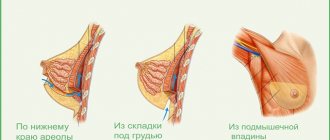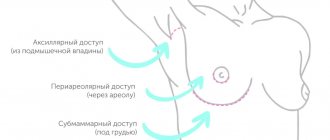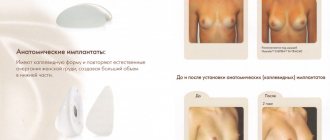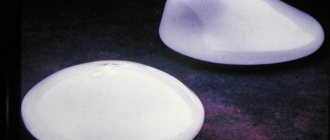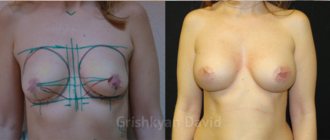Also represented and respected on the Russian market are Eurosilicone and Allergan. These are generally recognized leaders; product safety is constantly monitored and controlled by manufacturers. Typically, each patient’s medical history includes a lifetime warranty on prostheses from the manufacturer. Since there are no universal implants that would suit everyone, if you decide to enlarge your breasts, it makes sense to understand the specifics of these products and learn about the different methods of installing prostheses. To make the picture as clear as possible, during the preparation of this article, the authors contacted ten clinics that specialize in this operation.
Breast Augmentation – Breast Implants
Breast augmentation is most often performed through breast implants. The first breast implants made from silicone were created back in the 1960s and have made a lot of difference
Initially, there was much doubt about the quality of the implants, especially since the risk of complications associated with their durability and surgical intervention was relatively high. What happened to lovers of large breasts. The implants burst during flights and physical exertion, moved and became deformed for no reason, and often caused complications - tissue fibrosis. But this did not stop women striving to look sexier.
The fifth generation breast implants currently in use are characterized by very good quality, a high degree of safety and, most often, a lifetime guarantee. They are made from a silicone bag filled with a thick gel. The implant shell is durable and resistant to damage. According to the manufacturers, even if the top layer of the implant is damaged, leakage is prevented by the specific consistency of the gel.
Unlike previous versions, implants currently used in plastic surgery have a porous surface, thereby minimizing the risk of formation of pathological fibrous capsules in the breast. But since each person’s body is individual, no surgeon can give a 100% guarantee that everything will go smoothly. Complications, although rare, do occur: implants move down and to the sides, leak and simply become boring.
Compound
Since their introduction in the 60s, implants have undergone significant evolution. Now the third generation of implants is in use. They are made of thin silicone, filled with viscous silicone gel and have a barrier layer that prevents the gel from escaping through the shell.
Sometimes connective tissue develops around the implant, which can contract and thereby change the shape of the breast. This process is called capsular contracture. To avoid this pathology, the surface of current prostheses is textured, and this reduces the risk of developing capsular contracture to a minimum. (However, in the professional community, debates about the advantages and disadvantages of smooth and textured implants still do not subside). As for possible implant ruptures, such cases are very rare.
The reliability of modern implants is largely due to the consistency of the silicone filler. It is sticky, so it sticks to the shell, has shape memory and reduced diffusion through the shell.
There are three types of gel - soft, dense and “soft touch”, which has the consistency of jellied meat. Each of them has distinct advantages and disadvantages. Soft to the touch, indistinguishable from natural gland, but does not hold its shape very well. Dense breasts are very rarely deformed, but the breasts look artificial. “Soft touch” looks more natural, but still feels harder to the touch than natural breasts.
The gel can also be replaced with saline solution or hydrogel filler. There are two-chamber implants - the inner part contains saline solution, and the outer part contains silicone gel. By adding saline solution to the internal chamber during surgery, the surgeon increases the volume of the implant and corrects possible asymmetry.
It is worth noting that implants with saline solution have two disadvantages - the splashing of liquid, which can be heard by others, and an instant reduction in breast size when the membrane breaks. But in Russia such implants are not widespread.
As for the shell of implants, there is no point in dwelling on this issue separately, because experts say that, despite the difference in textures, they are all equally reliable. But the line of the Silimed brand is of interest, where the dentures are covered with micro-foam-polyurethane sponge. The line is designed specifically for problematic tissues, including reconstructive operations on the mammary gland. Thanks to this coating, over time the implant grows into the surrounding tissue and is firmly fixed.
Types of Breast Implants
A patient deciding to enlarge her breasts with implants can choose one of two options.
- Anatomical breast implants. They have a teardrop shape and are used in most cases for women who want to improve the shape and appearance of their breasts. They are especially recommended for asymmetrical breasts that have lost firmness and are prone to sagging.
- Round breast implants. They are used when the patient intends to enlarge small and flat breasts that do not have problems with sagging.
Breast augmentation with implants requires a perfect fit, so consultation with an experienced doctor is very important. The plastic surgeon must clearly determine the feasibility of achieving expectations regarding the results after surgery, taking into account all the possibilities offered by plastic surgery.
It is important to note that the desired breast size should match the silhouette or circumference of the woman's chest. The correct choice is facilitated by computer modeling of the bust after surgery. Too large breasts on a fragile woman will look unnatural, so it will not be possible to hide the fact of visiting a plastic surgeon.
Breast implants
Form
There are two main forms of prostheses - round and anatomical. Round ones can be low-profile - in the shape of an inverted saucer, and high-profile - their shape resembles an inverted bowl. There are many options for anatomical implants.
In order for anatomical prostheses to keep their shape, they must be filled with a dense gel. Despite the obvious advantages, this also has a disadvantage - the shape always remains the same, regardless of the underwear and body position.
Most experts consider a round low-profile implant to be optimal; it is a top seller. But, of course, in each case the choice is determined by the natural shape of the gland, the condition of the tissues and personal preferences.
Breast augmentation surgery using implants
Breast augmentation with implants involves the need for surgery. Before performing it, you need to undergo a series of tests that exclude certain contraindications. By the way, there are quite a lot of them. For example, breast augmentation surgery cannot be performed on patients with diabetes and autoimmune diseases, due to the high risk of implant rejection and poor tissue healing in such pathologies. Patients with blood pathologies, inflammatory processes, etc. will also be denied surgical breast augmentation.
At the appointment, the surgeon informs the patient about preoperative requirements, such as avoiding tanning and taking certain medications. For example, you should not take any drugs associated with changes in blood properties, antidepressants, etc.
Breast augmentation surgery usually lasts 1-2 hours. The patient undergoes sedation (minor anesthesia) or general anesthesia. The doctor performing the procedure makes an incision under the skin and then creates a pocket into which the implant is placed. Next, a drain is placed and the wound is sutured. The hospital stay usually lasts 1-2 days.
Recovery after breast augmentation surgery takes 3-4 weeks. However, physical exercise can only be done after 6-9 weeks. After surgery, you need to be prepared for pain and general discomfort. During the recovery period, it is extremely important to wear a special compression bra.
There is no need to replace the implant if it is of very high quality, confirmed by the manufacturer's lifetime warranty. However, if necessary, you can remove the implant or replace it with another one, for example, a larger or smaller one.
Breast augmentation with implants can provide very natural-looking results. For this, teardrop-shaped anatomical implants are used, which help improve not only the size, but also the appearance of the breast. Also, if you ignore the surgeon’s advice and postoperative recommendations, you can get the opposite effect and complications.
Non-surgical breast augmentation with hyaluronic acid
Breast enlargement without surgery is possible thanks to the use of hyaluronic acid. This organic chemical compound is used in aesthetic medicine in the form of a gel. What is important is that this is a truly effective, safe, almost natural filler.
Hyaluronic acid can be injected into various parts of the body, including the breasts, to provide breast enlargement effects. The procedure also helps to lift and strengthen the bust and improve the shape of the breast. Hyaluronic acid is often used to enlarge the labia.
Non-surgical breast augmentation using hyaluronic acid is a low-traumatic procedure and therefore has virtually no complications. The drug is injected into the chest through an incision several millimeters wide, so the patient is left with no visible scars. A huge plus is that the procedure is performed under local anesthesia, and the woman can immediately return home and go about her daily activities.
In the first days after surgery, it is recommended to wear a bandage applied in the clinic. Also, during the first 2 weeks, it is advisable not to lie on your chest and not to visit places with high air or water temperatures.
It is important to understand that the effect of breast enlargement with hyaluronic acid will not be permanent, it lasts from 16 to 30 months. This fact can be considered both a disadvantage and an advantage. If the patient is satisfied with the results achieved, the procedure can be repeated. If the presence of gel in the breast is undesirable, for example, for women planning pregnancy and breastfeeding, the reversibility of the effects of hyaluronic acid is a definite plus.
Non-surgical breast augmentation with hyaluronic acid
Lipofilling
Breast lipofilling causes a lot of controversy, and there is no clear decision regarding its safety. The method involves injecting the patient’s own fat into the breasts, taken from the patient’s problem areas. Fat transfer is performed using a specially shaped tube or syringe through incisions. Proponents of the method claim that your own fat is not rejected by the body and is not absorbed. The effect depends on the individual characteristics of the body, but the procedure can be repeated every six months. Opponents talk about the frequency of fibrosis and inflammatory processes. It is not uncommon for the transplanted fat to become encapsulated; these capsules become dislodged and deform the breast.
Breast augmentation with fat
Breast augmentation using your own fat allows you to achieve the natural effect of large breasts, which is why many patients choose this method. For people who choose to use this method, fat is taken from a selected part of the body (this could be the thighs, abdomen, abdomen or buttocks) and then transplanted to the breast area.
Fat augmentation is performed under sedation (light anesthesia), so before performing the procedure, the patient must undergo all necessary examinations and follow the surgeon’s recommendations.
The first stage of the procedure is to collect fat from a predetermined location on the body. The fat is sucked out through a small incision and then cleared of blood, serum and liquid fat. In the second stage, small amounts of fat are injected into different parts of the breast using special cannulas.
To minimize the risk of fat graft rejection, only a limited amount of fat can be injected at a time. Therefore, if a woman expects more impressive effects, the breast augmentation procedure using her own fat must be repeated after 4-5 months.
After the procedure, the patient can immediately resume daily activities. Some discomfort and pain will be felt for some time, but the intensity of these symptoms should not be great. In the first weeks you will need to avoid wearing a bra, chest compressions and high temperatures.
Installation methods
The prosthesis can be installed in different ways. It is placed completely under the breast only if your own tissue is sufficient to completely cover it. If there is not enough tissue, the implant will be contoured in the upper part of the breast, and folds may form along the inner edge of the breast. To avoid these troubles, the surgeon often chooses a combined installation method - part of the implant is placed under the muscle, part under the gland. If the breasts are very small, they resort to completely installing the prosthesis under the muscle.
It is known that breasts droop over time after surgery, a process called ptosis. But doctors have not reached a consensus on which method of implant installation involves the least risk of ptosis.
There are only three possible access methods for placing implants: inframammary, along the nipple areola and under the arm. The first is the simplest, but involves visible scars. Periareolar is possible if the areola is large in diameter. The axillary approach masks scars well, but healing after such an operation takes longer than usual. Typically, each surgeon has his own favorite method of access.
